Camping is one of the best ways to connect with the great outdoors. There is something magical about sleeping under the stars and being exposed to any weather. Camping is very versatile from fun family camping trips to festival goers to backpackers and the hardcore mountain climbers. This Camping Packing List was designed around trekking in Patagonia and backpacking. So the equipment focuses on being lightweight, compact and strong to handle the strong winds. The List includes the tent, sleeping system, cooking equipment and other items to make your camping experience as comfortable as possible! For hiking and trekking clothing and equipment to compliment this camping packing list, check out the Ultimate Trekking Kit List.
Camping Packing List
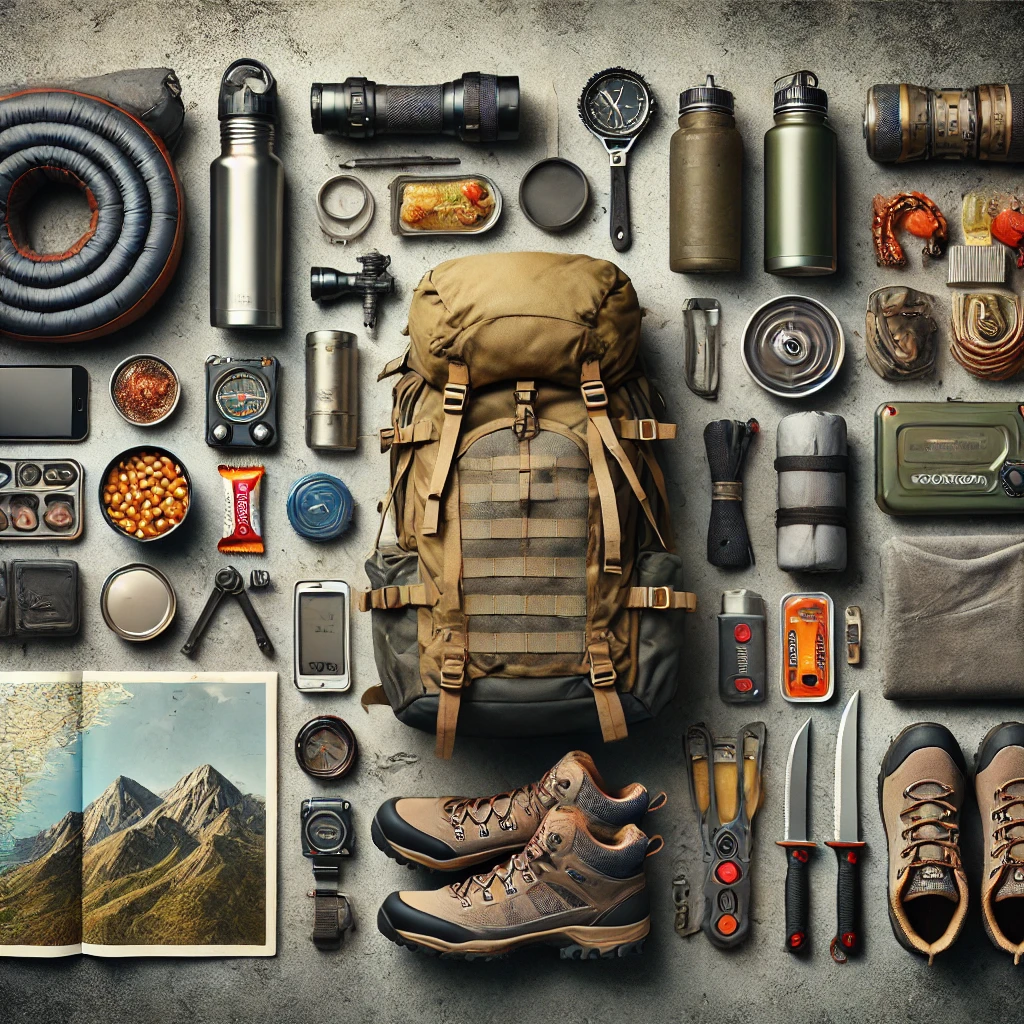
This Camping Packing List focuses on general camping gear for outdoor lovers to begin camping. Camping is a fantastic way to access the great outdoors and enjoy a night under the stars. The basics of camping are to pitch a tent on the ground and then sleep inside sleeping bags. Camping is a huge industry with tent sizes varying from 1-person ultralight tents up to huge family style tents. Then there are campervans, caravans, motorhomes and RVs which are another level of luxury but can share a campsites facilities. Tent camping is a simple way to safely sleep outside whether paying for a campsite or wild camping. Cooking at a campsite generally uses gas stoves to cook easy meals outside (weather permitting) or within communal kitchens. Normally, there are sinks for washing cooking equipment and showers/toilet faculties to clean yourself.
The Tent
The essential equipment for any camping packing list is a tent. The main part of camping is sleeping overnight in a temporary shelter such as a tent or hammock. I first started camping with Scouts as a young lad and practised putting up heavy army style tents. Luckily technology has vastly improved over generations and provides more comfort and protection for less weight or size. Like most outdoor equipment, the price you pay will generally get you better quality and lighter materials. However, buying a tent and sleeping bag can cost as little as £50! For years, I used a 3 person Vango Spectre which while reliable and spacious in length but it wasn’t the lightest. So when I got into Trekking and fancied camping instead of hostels (to save money), an upgrade was much needed!
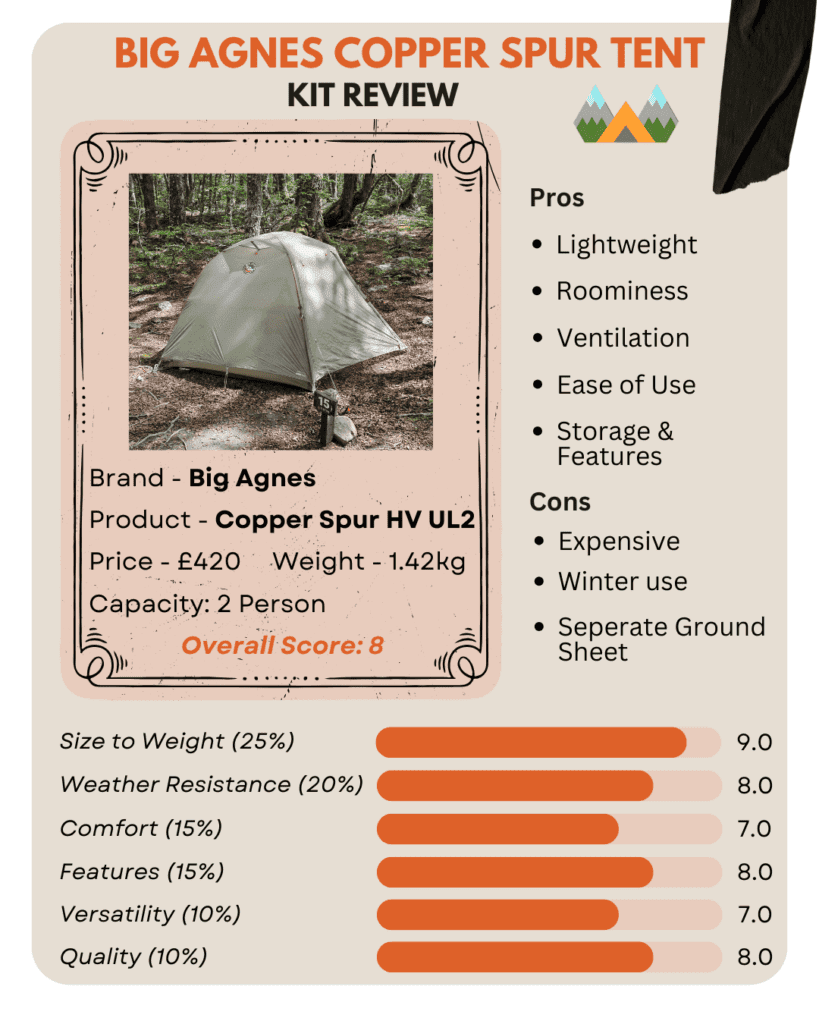
Big Agnes Copper Spur HV UL2
I opted for the popular Big Agnes Copper Spur HV UL2 Tent because it’s a 3-season, free-standing ultralightweight tent. The top reasons I recommend the Copper Spur are the amount of space for the weight, the stability & waterproofness. The tent could be pitched in 5 mins and the stuff pack made it easy to roll up. The Copper Spur handled heavy rain and snow well but the 70mph winds were almost too much. There are cheaper tents on the market but the quality material used and abundance of smart features meant, there was more comfort.
The Big Agnes Copper Spur UL2 is one of the best lightweight 2-man tents on the market. If it’s within budget, the Big Agnes is an amazing tent that will give you comfort and space to enjoy your adventures and not worry about a bad night’s sleep. There is an optional ground sheet to protect the tent and can double as a Tarp. For for the full Review, check out Big Agnes Copper Spur UL2: The Best Trekking Tent
Sleeping System
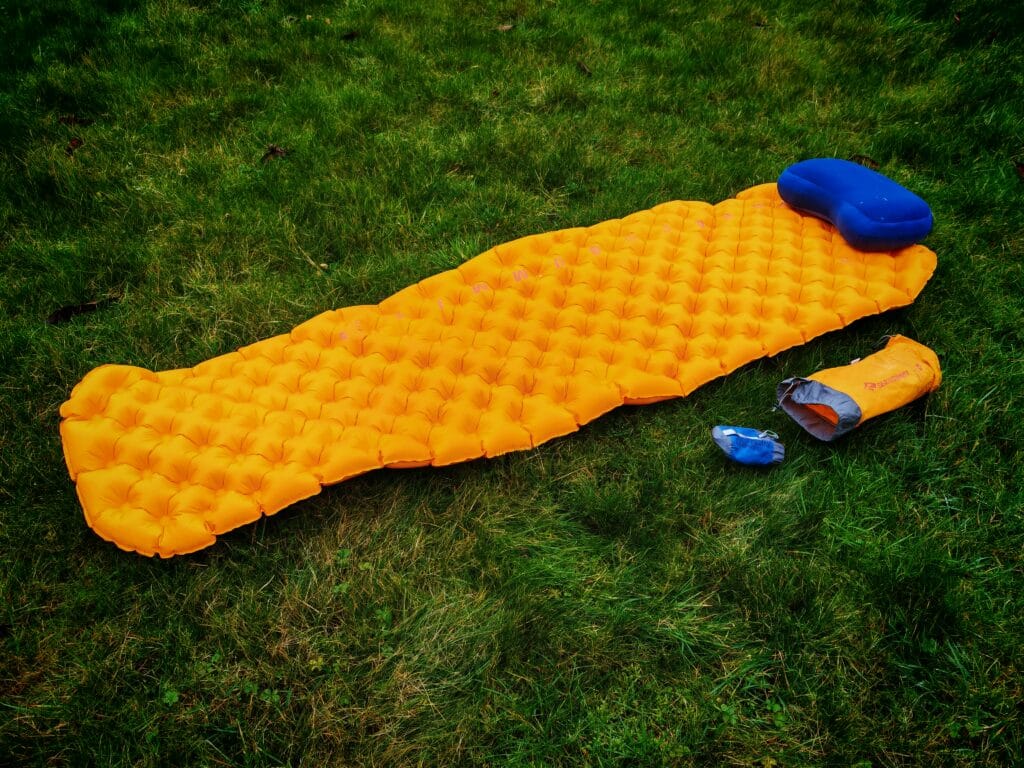
Sleeping Bag
Once you have a roof (even if its very thin) over your head, you need something to replace your bedding. Traditionally a sleeping bag is the most common way to keep warm when in a tent. Sleeping bags ranging from summer only temperatures down to 4-season winter ready sleeping bags. Before Nepal, I chose the Rab Alpine 800 Sleeping Bag which has a temperature range down to -25degress. Despite not being ultralightweight, the warmth is priority for a 4-season sleeping bag which is where the down feathers have an advantage. And I use sea to Summit compression Sack to pack it down.
Sleeping Matt
My camping equipment was in dire need of an upgrade and a sleeping mat was high on the list. After researching Big Agnes, Thermarest and Nemo, I decided on the Sea to Summit Ultralight Insulated Sleeping Mat paying £82 instead of £130 RRP. The key selling points were the good 3.1 R-Value (Late spring to early autumn) and how small it collapsed into for packing. The noise of the baffles have been a complaint by some customers but I didn’t notice much compared to the comfort offered. It was noticeable the difference in temperature on the ground with and without it! The inflation used the stuff sack as an air pump to quickly inflate with 4-5 bag full of air. Even though it is lightweight, the materials are durable and the valve system is handy to adjust the inflation and deflate quickly.
Sleeping Bag Liner
I can not high recommend a sleeping bag liner enough! For nights when it’s warm outside and a sleeping bag is too, warm then a sleeping bag liner is a great option. They pack down to the size of a pair of socks and add a few precious degrees of warmth. Unfortunately the Rab Silk Ascent sleeping bag liner is not available with the replacement being a cotton liner. The silk adds a silky texture and comfort within the bag itself and helps keep the sleeping bag clean too. I often pack this for trips away instead of a sleeping bag or for a hostelling trip.
Inflatable Pillow
Another great buy for camping and gamechanger for getting a great night’s sleep is a pillow! I choose the Sea to Summit Aero inflatable pillow as it is ultralight (60g) & packable down to 5.5 x 7.5 cm. The pillow has a soft outer with contoured baffles to help the comfort factor. It doubles as a travel pillow very well for planes, trains or coach journeys.
Cooking Equipment
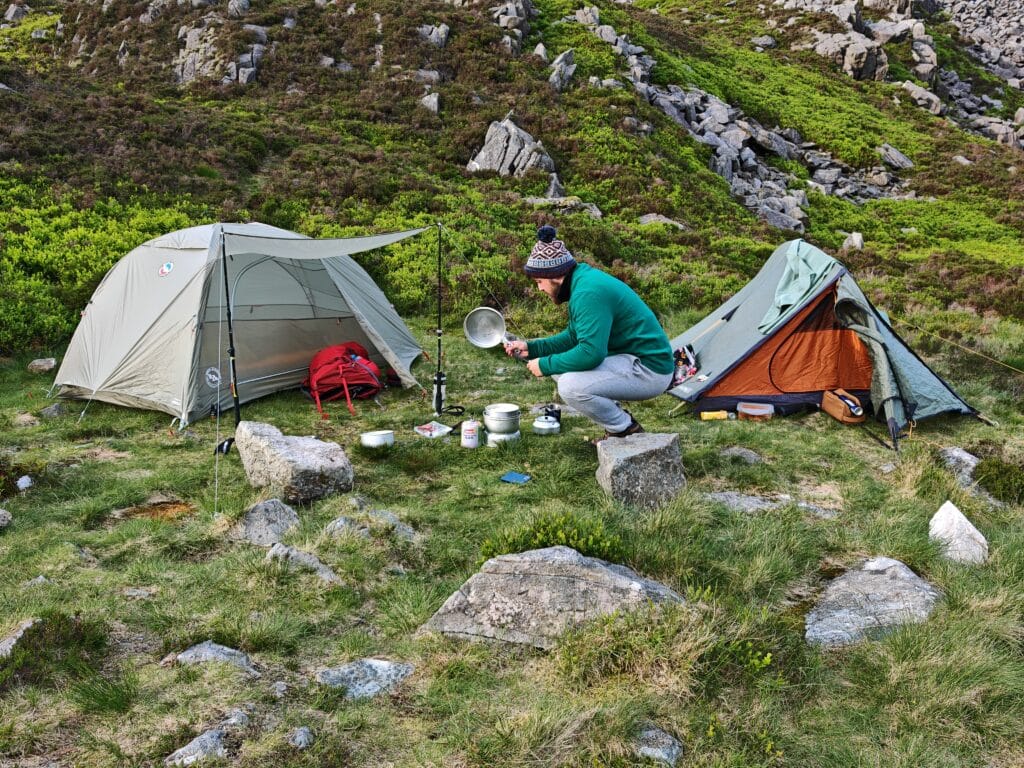
Stove & Gas
While a camp-fire barbeque is tempting, a gas stove is a much more efficient way to cook food. A small canister of gas (a mix of Butane/Propane) will cost around £5 each and last typically 10g of fuel to boil 1 litre. The stove attachment will cost at least £20 and takes up minimal space for trekking. A lot of campers use Jetboil style stoves which has an integrated water cylinder to boil it very quickly. These integrated cooking systems start at around £60 for an Alpkit Brukit and can extend up to multiple hundreds with a balance of efficiency, size and weight.
Pot/Tin & Utensils
If you are camping on a trek then backpack weight will become a limiting factor. Realistically, don’t expect gourmet meals using a camping stove but it’s easy to still make tasty and nutritious food. A mess tin or pot to cook food is a good start with a kettle to quickly boil water. A Trangia Crookest is a good alternative to using a gas canister where methanol fuel is added to the burner to cook. The pots and pans included are compactly packed and work well on a stove as well. A small knife is always useful to help prep any food or open packages and then to eat a trusted Spork never goes a miss. The Sea to Summit Delta: is a cheap and well-made plastic spork with a different design that has a knife on the handle instead of the side of the fork element.
Food
Food & cooking equipment are one of the heaviest items to pack on a trek and given you will need 3 meals a day plus snack to fuel properly, it’s wise to pick strategic foods. Instant or dehydrated meals are a safe and effective dinners requiring only boiled water to prepare. I recently used Tentmeals which are vegan dehydrated meals and were very fragrant and fresh compared to others. There are many companies selling pre-cooked and ready to eat meals for around £7 per a meal which will save the pain of cooking a fresh dinner with limited space or equipment. Instant oats are a great breakfast as take up little space and provide a filling and diverse feed. Trail mix, dried fruits and snacks are always needed for an outdoor adventure especially when hiking to keep the energy levels and morale high.
Collapsible Bowl
The Sea to Summit X-Bowl is a collapsible camping bowl that takes limited space and is versatile. It doubles as a chopping bowl and has a great capacity-to-weight ratio. It was super easy to clean and kept the food warm for a good amount of time so I would highly recommend instead of a traditional mess tin.
Mug
There is a joy in enjoying a hot beverage after a long hike with a beautiful view of the wilderness. A quality camping mug is pretty handy for teas and coffees which will warm you up fast. The Toaks Titanium Camping Mug is a lightweight & strong metal mug with a clever handle to pack away neatly.
Hydration Bladder
A hydration bladder is a great way of easily carrying larger quantities of water compared to a water bottle. For multi-day trekking without access to tap water then a larger capacity is an advantage to stay hydrated. Recently, I upgraded to the Gregory 3D 3L Bladder for more capacity, better valve control and easier cleaning.
Water Purification
Lifesystems Chlorine Dioxide Tablets are more expensive than Chlorine ones but more effective in killing bacteria and viruses. Especially when camping, finding fresh clean water is important for hydration and food cooking. If carrying litres of water is not preferred, then water purification tablets, droplets or a straw-system allows water to be purified easily. The traditional approach is to boil the water to kill any bacteria.
Lighter/matches
To light the Gas stove or fire, then matches or a lighter will save a lot of time and stress. Simply, no ignition will mean no hot food!
Sponge & Soap
A small sponge and multi-purpose soap is useful for washing up bowls, mugs and cooking equipment in a sink. Be careful when washing in natural water streams to not pollute the water with chemicals.
Camping Packing List Miscellaneous
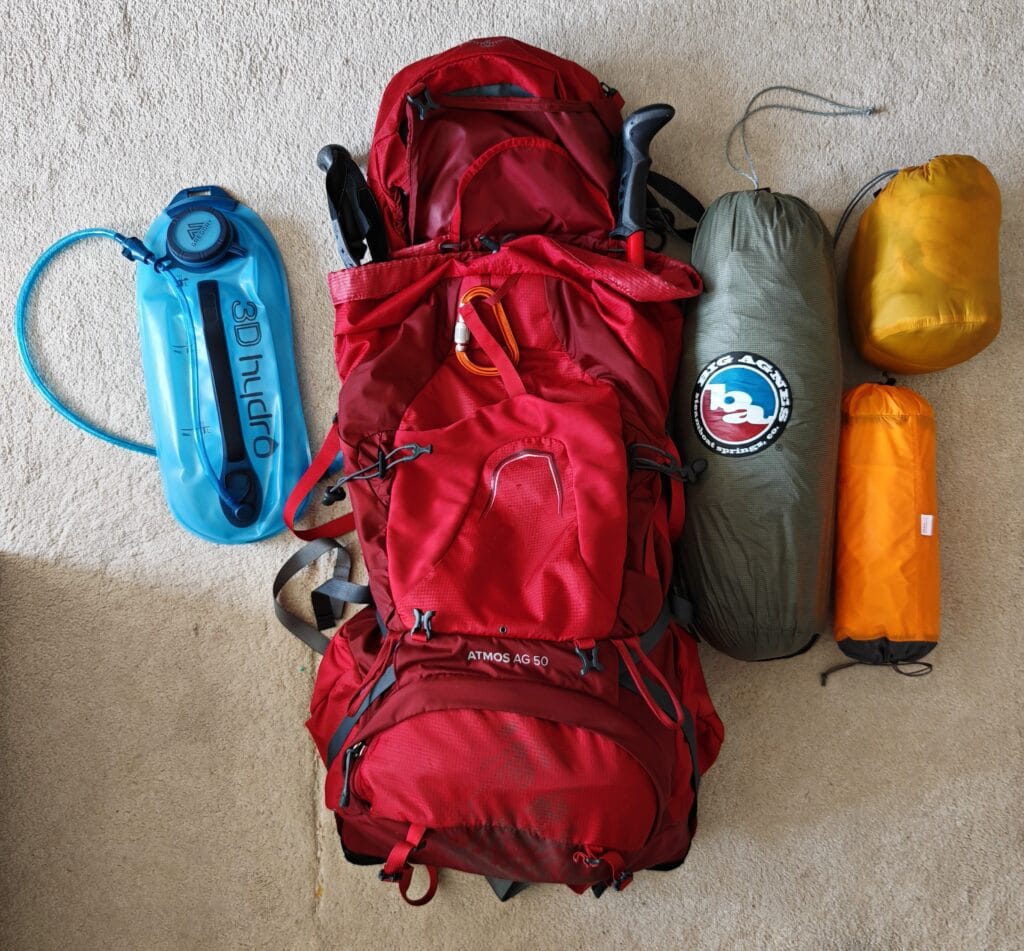
Backpack
Osprey Atmos 50 AG
The main kit for trekking is your backpack and finding the right size and features for you is key. Depending on the length of your trek and what accommodation/meals are chosen will influence the capacity needed. I decided on 50 litres as it would hold everything for up to 2 weeks and minimize overpacking. After weeks of research, the Osprey Atmos had glowing reviews for the Anti-Gravity system which is incredibly effective.
Headtorch
After sunset, a form is light to navigate around camp and see inside the tent is necessary. The Petzl Tikkina is a compact 300-lumen single-banded headtorch with great battery life has saved me on a few pitch-black trails. A tip is to hang them from the tent ceiling to act as a light and a headtorch allows you to explore a nigh time (for example embark on a sunrise hike!).
Sliders/Camp shoes
It’s wise to take a 2nd pair of shoes or sliders for use around camp. Sliders or Sandals are in particular good when visiting the toilet or showers. I have tried using sandals or sliders as my 2nd shoes when trekking or camping but the Rab Cirrus Hut Slippers are much cosier and grippier. They compact well to fit next to the sleeping bag which is useful when packing space is limited,. They have had multiple compliments even if they do lack some support and grip.
Trekking Poles
Trekking poles aren’t just used to help with hiking but are useful around camp! Poles are used in Trekking Tents where they replace the metal tent poles and use these as the structure. The Big Agnes Copper Spur UL2 uses trekking poles to pin out the awning style vestibules to add protection from sun or rain. For years I have used the tried and tested Leki Makula AS which have a soft anti-shock suspension to absorb the force, comfortable grips and a good locking system.
Multi-tool/ Knife
It’s not often I would recommend buying a knife but a good old fashioned swiss army knife has many purposes. I tend to use a Victorinox Swiss Card Lite because of how small and compact it is. However. Occasionally, I use a Victorinox Hiker Swiss Army Knife as it has a screwdriver, a larger blade, a saw and a better bottle opener. which is more suited to camping! Another option for a blade, is an Opinel pocket knife which are extremely sharp (warning I have accidently cut myself multiple times so be careful!)
Toilet Paper & trowel
Most campsites will have toilet facilities however if you’re wild camping then nature is your bathroom. Toilet paper is a basic hygiene item and as I found out in Nepal, it’s much needed to stay clean. If wild camping and you need to go, then a small trowel to dig a hole and fill in is good practise.
Camping Packing List Optionals
Camping Chair/Matt
A camping chair or matt to not sit on the cold floor does feel like a luxury item but will improve the comfort factor a lot! Camping chair designed for backpacking can cost upwards of £100 due to the lighter weight and packability compared to much cheaper versions. A much cheaper option is for a padded or inflatable matt to sit on such the Therm-a-Rest Z Seat.
Power bank/ Solar Charger
As much as I love escaping into the wild and going off grid, the reality is technology is still useful. Whether it’s to navigate, take pictures or as an emergency, you don’t want to get caught with a dead battery. So a solar charger or a large Power Bank will keep you topped up. I recommend the Anker 325 which despite the added weight gives me 4 full phone charges. A smaller 1 charge Power Bank would be better with a heavy backpack.
Wild Camping
Wild camping involves sleeping in a tent away from an organised campsite such as in a field, up a mountain or by a lake. It is a free and relaxing way to escape the bustle of modern life and works well if doing a multi-day hike off the beaten track from normal trekking routes. The legibility of Wild Camping is a grey area in the UK where some places (Scotland) it is permitted however it is illegal on private land or national parks (Lake District) so for England, Wales & Northern Ireland you should check the land owners permission to stay the night. Having said this, there are some simple rules that if you follow, will keep yourself safe, avoid a nasty conflict and leave the environment as you found it.
Wild Camping Advice
- Leave No Trace – A simple rule is to leave the camping spot as you found it and take all litter back with yourself. If you leave the area so no one could tell you’ve stayed, then that is ideal
- A Remote Spot – It’s advisable to sleep high up or at least 500m away from civilisation. This is more enjoyable being away from people finding a remote and beautiful spot to camp.
- Arrive Fashionable Late and Leave Early – It’s best to avoid busy areas and try to arrive after most people have left. From experience, try to pitch a tent in day light in the late afternoon/evening and leave the next morning.
- Camp fires – Be careful with where you make a fire as you don’t want to start a wild-fire. So keep any fires small and controlled.
- No Parties please – It’s better to keep groups to a minimum and try not to be too loud to disturb nature or other campers. Sleeping at night can be hard enough without loud music.
- For One Night Only – Only camp in one spot for a single night then move on. For multi-day hikes, this is easy but for a longer camping trips, try to research and plan a couple of wild camping spots.
- Clean Water – Access to clean water is tricky so one option is to carry several litres for any cooking and washing. Otherwise, it’s good to camp near flowing water to save carrying the extra weight. Remember to check upstream for any waste and collect as close to the source to reduce risk. Also boil the water and use purification to ensure it’s safe to use.
- Leave a note – It’s always wise to tell someone where exactly you’ll be spending the night in case of an emergency.
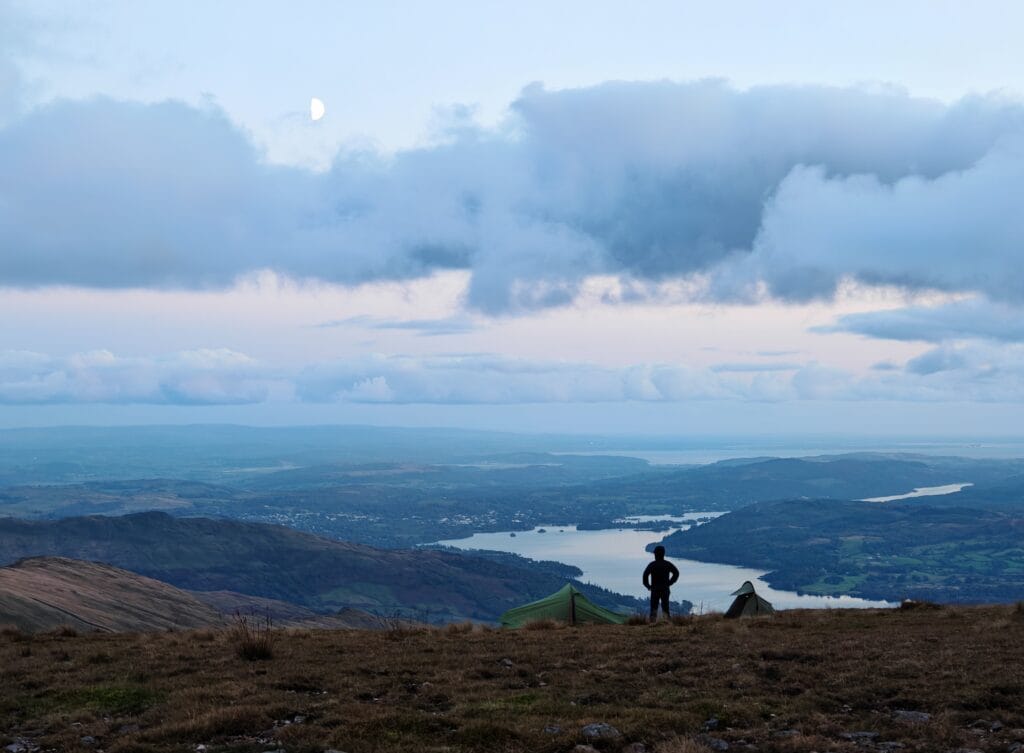
Final Thoughts
Camping has been a love of mine for years and gives a great feeling of being outdoors. Even though there is more comfort in hostels, AirBnBs or Rifugios, camping offers a unique exposed experience and way of spending the night outside. Staying at a campsite is much cheaper too than other accommodations which keeps money ion your pocket for more adventures. And stepping into the world of wild camping allows an even further connection to nature. This Camping Packing List is a starting point to guide you into the world of camping and helps to plan a trip with all the necessary gear.
Soon, I will be posting a Tips for New Campers to compliment this Camping Packing List to help give further advice on making the most of a camping trip. What is your favourite camping equipment? If you are enjoying the blogs then please sign up to The Journal Newsletter below for monthly publications. And please share the posts with fellow travellers who are looking for adventure inspiration or research.
Pingback: Ultimate Tips for New Campers: The Joys of Camping - Backpacker's Mentality
Pingback: Sea to Summit Ultralight Insulated Sleeping Pad: Reasons to Love it - Backpacker's Mentality